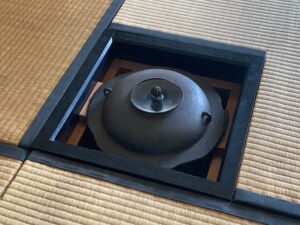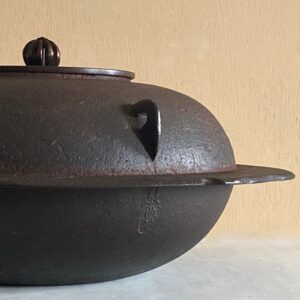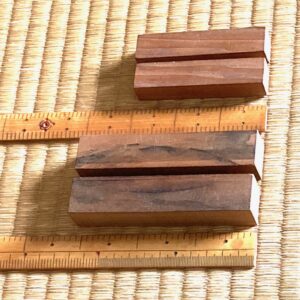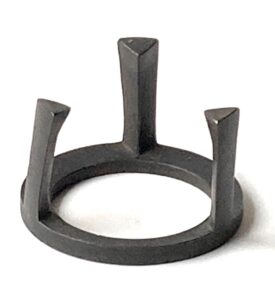Sukigi Gama

Suki-gi gama, 透木釜, pass through-wood kettle, tetsu, 鉄, iron, with wide flaring hane, 羽, wing, with overall pattern of shiki matsu-ba, 敷松葉, spread pine-leaves (needles). With lid of Kara-kane, 唐銅, Tang-copper, bronze, by Taka-hashi Kei-ten, 高橋敬典, High-bridge Respect-celebrate, Nin-gen Koku-hō, 人間国宝, Person-interval National-treasure. The diameter of the body of the kama is 8.5 sun kane-jaku, and the diameter of the hane is 8.5 sun kujira-jaku. The hane rests on sukigi, wooden blocks, placed on the copper ro-dan, 炉壇, hearth-foundation. The ro-buchi, 炉縁, hearth-frame, has a thinly applied black-lacquer finish called kaki-awase, 掻合, scrape-gather, which shows the wood grain beneath.


Pairs of suki-gi, 透木, clear-wood, large planks for ro, sakura, 桜, cherry; L. 3.9 x .8 x .7 sun kane-jaku, shown with kujira mono-sashi, 鯨物差し, whale bend-span thing-distinction, ruler; it reveals that the sukigi for ro is 3 sun kujira-jaku.
Small sukigi for fu-ro, 風炉, wind-hearth, made of sakura, L. 3 x 6 x 5.5 sun kane-jaku.
The presence of the number 3 shows that the sukigi length is 3 sun, regardless of the actual size. It should be remembered that the go-toku, 五徳, five-virtues, is not used with the sukigi-gama, and the gotoku has three legs that support the kettle.
Futa-oki, 蓋置, lid-place, go-toku, 五徳, five-virtue, black-patinated Kara-kane, 唐銅, Tang-copper, bronze; diam. 2 x 1.2 sun kane-jaku: may be used with both fu-ro, 風炉, wind-hearth, and ro, 炉, hearth. The ratio between the height and diameter is 6:10. The number six is symbolic of Infinity in Time.

It was common practice to use gotoku in the irori, 囲炉裏, enclose-hearth-inner, with the ring upright and the legs in the ash. It was Rikyū who turned the gotoku over, so that the three legs were upright and the ring in the ash. Not having the gotoku in the ro in the third and fourth month, and using the gotoku futaoki, we are remembering Rikyū when handling and turning it over.
The measurement of the length of the sukigi for the ro in my collection is 3.9 sun kane-jaku or 3.1 sun kujira-jaku. I wondered if its measurement has some connection with the measurements of the ro. The ro opening is 14 sun kane-jaku. The distance between the inside of the walls of the robuchi is 11.6 sun kane-jaku or 9.28 sun kujira-jaku. Neither size appears to have symbolic significance. Perhaps the sukigi block is one-third the size of one of the measurements of the ro. The kane-jaku measurement of the robuchi of 11.6 divided by three equals 3.866, which is .03 less than the length of the sukigi.
When three sukigi blocks are placed on the rodan, they are too long for the opening. The measurement between the inner edge of the top surface of the robuchi is to be considered. The outside measurement of the robuchi is 14 sun kane-jaku. Subtracting one sun from each side of the frame the width of the top surface of the robuchi, leaves 12 sun. 12 divided by 3 is 4, or 4 sun for the length of the sukigi. The length of the sukigi in my collection is 3.9 sun kane-jaku, which is .1 sun kane-jaku shorter than the 4-sun measurement. This difference allows space for the saw blade that cuts the wood. The inner opening of the rodan measures 10 x 10 sun kane-jaku or 8 x 8 sun kujira-jaku. It is likely that the specific measurement is kujira-jaku, as the measurements of the charcoal for ro are made using the kujira-jaku.
The suki-gi blocks are made of various kinds of wood: Rikyū’s choice was kō-boku, 厚朴, thick-simple, big leaf magnolia bark used in traditional Chinese medicine for thousands of years. The bark of magnolia has been traditionally used also in Japanese medicine for the treatment of anxiety, asthma, depression, gastrointestinal disorders, headache, and more.
Other woods for sukigi include kiri, 桐, paulownia, sakura, 桜, cherry, sugi, 杉, cedar, etc. Each sukigi block does not have a square cross-section: the measurements for ro sukigi are .8 x .7 sun kane-jaku. Some sukigi are the size of one of the large sukigi cut in the half of its width.
For further study, see also: Tea in April, May: Still Following Elephants, and Furo to Ro

